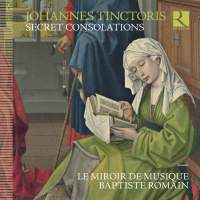Texte paru dans: / Appeared in: |
|
|
Outil de traduction ~ (Très approximatif) |
|
|
Reviewer: Barry
Brenesal Johannes Tinctoris (c. 1435–1511) survives in modern memory as an important late 15th-century musical theorist, one of the first to articulate the idea that training the ear was an important part of developing musical comprehension. (A project at earlymusictheory.org is currently under way to place online a new edition of his extant theoretical works, with full Latin texts, English translations, and commentaries.) But he was also a composer, both of music intended for performance, and didactic compositions intended to instruct. This recording is the only one currently in print devoted entirely to Tinctoris’s works, though used copies are still available online of two of the composer’s Masses performed by Edward Wickham and his ensemble, The Clerks’s Group (Cyprès 3608; Fanfare 23:4).
The collection assembled here under the title of Secret Consolations is commendably varied. Of its 19 cuts, 15 are by Tinctoris and include motets, chansons, Mass movements, and instrumentals—both variations on the works of others, and arrangements of his vocal music. Of especial interest is a Mass that Baptiste Romain, singer, instrumentalist, and director of Le Miroir de Musique, in effect builds around the three surviving movements of Tinctoris’s Missa sine nomine 3. (It exists as an unicum in one of the four codices of Franchinus Gaffurius kept in Milan Cathedral, from a time when the Ambrosian liturgy had no Kyrie or Agnus Dei. Presumably only the Kyrie, Gloria, and Credo were acquired by Gaffurius from an unknown source, during his tenure at the Cathedral as maestro di cappella.) The Kyrie is taken from the composer’s Missa l’homme armé, and the Agnus Dei, from his Missa sine nomine 2. It is not a coherent Mass as a result, though elements in the Kyrie’s head theme are congruent with that of the Missa sine nomine 3; and it’s arguably made less so by the instruments-only arrangement of the Credo. Still, the faster tempo and strongly rhythmic treatment go some ways to explaining the contemporary attraction in recasting sacred music as instrumentals for secular performance.
On this album, Baptiste Romain’s Le Miroir de Musique includes 10 singers, five of whom are added solely for the Mass movements. The others include a bass, baritone (Romain himself), tenor, mezzo, and soprano—the last being Sabine Lurzenberger, whom I praised in a previous release by the ensemble (The Birth of the Violin, Ricercar 333; Fanfare 37:4). She offers a well-focused, delicate lyric voice, with good agility in her light figurations. Her performance in Tinctoris’s Vostre regart si tresfort m’a feru is a fine example of her art, while the ensemble delivers a solid, if not ideally smooth, reading of the anonymous Ou lit de pleurs, paré de plaintz. The instrumental core of the ensemble consists of four performers, on plucked and bowed strings. They are responsible for eight out of the 19 cuts, performing both expertly and with great clarity between the parts. Credo aside, they can be heard to best advantage in a series of three variational sets woven around a rondeau of Ockeghem’s D’ung aultre amer, one each by Spinacino, Tinctoris, and Agricola.
In good
sound, with excellent timings, this is a most welcome release of music by a
composer whose freight of learning and eye for lexical detail obscures the
quality of his own music. Recommended. | |
|
|
|
|
Cliquez l'un ou l'autre
bouton pour découvrir bien d'autres critiques de CD |
|




